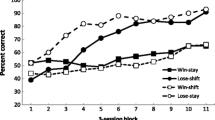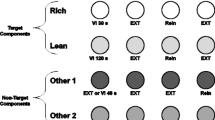Abstract
In the first experiment, albino rats were studied under gradually increasing and decreasing fixed-ratio schedules of food reinforcement. All of the rats maintained either a one- or two-pawed lever press throughout the experiment, and they all showed a direct relationship between ratio size and the duration of the postreinforcement pause. In Experiment 2, Mongolian gerbils were studied under relatively prolonged and unchanging fixed ratio requirements. Almost all of the gerbils showed changes in response topography from the two-pawed press, which had been shaped initially, to species-specific responses in the form of scratching and biting of the lever and scratching of the test chamber wall. The changes in response topography were unrelated to changes in schedule requirement. Experiment 3 studied the development of response topographies in gerbils under increasing fixed-ratio schedules, when no shaping technique was employed. All of the gerbils developed consistent responding within several sessions, and scratching and biting of the lever quickly emerged as the predominant response topography. Experiment 4 studied responding in gerbils with changes from fixed ratio to differential reinforcement at low rate (DRL) schedules. Again, scratching and biting of the lever was displayed by all of the gerbils, but the distribution of these responses in time was effectively controlled by the DRL schedule. The major effect noted was that under the fixed-ratio schedules the gerbils scratched and bit the lever, which produced high rates of response, while under the DRL schedules, they scratched and bit the chamber wall and floor grids adjacent to the lever, which resulted in low rates of response. These findings are evaluated in the context of instinctive behaviors which com-pete with, and sometimes replace, conditioned responses.
Similar content being viewed by others
References
ANDERSON, M. C, & SHETTLEWORTH, S. J. (1977). Behavioral adaptation to fixed-interval and fixed-time food delivery in golden hamsters. Journal of the Experimental Analysis of Behavior, 27, 33–49.
BARRERA, F. J. (1974). Centrifugal selection of signal-directed pecking. Journal of the Experimental Analysis of Behavior, 22, 341–355.
BOAKES, R. A., POLI, M., LOCKWOOD, M. J., & GOODALL, G. (1978). A study of mis-behavior: token reinforcement in the rat. Journal of the Experimental Analysis of Behavior, 29, 115–134.
BOLLES, R. C. (1972). Reinforcement, expectancy, and learning. Psychological Review, 79, 394–409.
BRELAND, K., & BRELAND, M. (1961). The misbehavior of organisms. American Psychologist, 16, 681–684.
CURLEY, M. D. (1977). The gerbil as a model of human grand mal epilepsyc Unpublished doctoral dissertation, University of South Florida.
FELTON, M., & LYON, D. O. (1966). The post-reinforcement pause. Journal of the Experimental Analysis of Behavior, 9, 131–134.
FERSTER, C. B., & SKINNER, B. F. (1957). Schedules of reinforcement. New York: Appleton-Century-Crofts.
GLICKMAN, S., & HARTZ, K. (1964). Exploratory behavior in several species of rodents. Journal of Comparative and Physiological Psychology, 58, 101–104.
HERRNSTEIN, R. J. (1977). The evolution of behaviorism. American Psychologist, 32, 593–603.
LOCKARD, R. B. (1968). The albino rat: a defensible choice or a bad habit? American Psychologist, 23, 734–742.
POWELL, R. W. (1968). The effect of small sequential changes in fixed-ratio size upon the post-reinforcement pause. Journal of the Experimental Analysis of Behavior, 11, 589–593.
POWELL, R. W. (1970). Probability of reinforcement and fixed-ratio responding: A model. The Psychological Record, 20, 73–80.
POWELL, R. W., & CURLEY, M. (1976). Instinctive drift in nondomesticated rodents. Bulletin of the Psychonomic Society, 8, 175–178.
SHETTLEWORTH, S. J. (1975). Reinforcement and the organization of behavior in golden hamsters: Hunger, environment and food reinforcement. Journal of Experimental Psychology: Animal Behavior Processes, 1, 56–87.
SHETTLEWORTH, S. J., & JUERGENSEN, M. R. (1980). Reinforcement and the organization of behavior in golden hamsters: Brain stimulation reinforcement for seven action patterns. Journal of Experimental Psychology: Animal Behavior Processes, 6, 352–375.
SKINNER, B. F. (1938). The behavior of organisms. New York: Appleton-Century-Crofts.
STADDON, J. E. R., & SIMMELHAG, V. L. (1971). The superstition experiment: A reexamination of its implications for the principles of adaptive behavior. Psychological Review, 78, 3–43.
VANDERWEELE, D. A., ABELSON, R. M., & TELLISH, J. A. (1973). A comparison of ratio behavior in the gerbil and white rat. Bulletin of the Psychonomic Society, 1, 62–64.
WEISSMAN, N. W., & CROSSMAN, E. K. (1966). A comparison of two types of extinction following fixed-ratio training. Journal of the Experimental Analysis of Behavior, 9, 41–46.
Author information
Authors and Affiliations
Rights and permissions
About this article
Cite this article
Powell, R.W., Curley, M. Analysis of Instinctive Drift, II: The Development and Control of Species-Specific Responses in Appetitive Conditioning. Psychol Rec 34, 363–379 (1984). https://doi.org/10.1007/BF03394880
Published:
Issue Date:
DOI: https://doi.org/10.1007/BF03394880




